How To Estimate Cattle Age By Their Teeth
In cattle, age is often estimated by examining their lower incisor teeth (cattle do not have upper incisor teeth).
Estimating cattle age by their teeth involves noting how many incisor teeth there are, what type of teeth they are ("baby" or "milk" teeth, or permanent teeth), their degree of wear, and overall appearance. This article will offer an introduction to the basics of how age is estimated in cattle two years of age and older.
Below: A three-year old cow. The green dots indicate the second pair of permanent incisors.

Becoming good at aging cattle by their teeth requires an understanding of the guidelines about how their teeth should look at a given age, as well as extensive practice examining the teeth in cattle of a known age. Learning to age cattle by their teeth strictly by looking at photographs probably isn't possible, but it can be a fun introduction to the basics.
Before we begin, there are several things to point out:
- In the text and photos of this article, we use the term "cow" loosely. For the purpose of this article, "cow" can refer to a cow, bull, steer, or heifer.
- Cattle have molars on the upper and lower jaws, but have incisors on the lower jaw only. It is the incisors that are used to estimate the cow's age.
- Cattle get their first permanent incisors around the time they're 1 1/2 years old, and typically have all eight of their permanent incisors by approximately age five. It is comparatively easy and accurate to tell a cow's age by her teeth during this period. After age five, estimating age becomes more difficult.
- The information on this page is for aging cattle by their permanent incisors, approximately two years of age and older.
- Aging a cow by her teeth is a general estimate, and may be inaccurate. This is well known and understood by anyone with experience in the cattle industry.
- Determining a cow's age by her teeth is a judgment call, and not everyone will estimate a cow's age the same.
How To Estimate Cattle Age By Dentition (aka The Arrangement, Condition, and Number Of Teeth)
Estimating a cow's age in a highly descriptive, too-many-details manner is usually not practical under working conditions. Therefore, in the photos below the shortest possible version of the cow's age will be given. For example, if a cow is estimated to be between the ages of four and five years, her age will simply be given as "five years."
Estimated Age vs Actual Age: In the photo captions below the "estimated age" was determined by examining the cow's teeth. "Actual age," if given, was known thanks to record keeping and the owner's personal knowledge of the cattle.
Age: Two
The first permanent incisors (blue dots) come in from about the time a cow is 1 1/2 years old to two years. By approximately age two years they are typically fully developed. They often come in at an angle and then straighten.
NOTE: Smaller teeth visible to the left and right of the first permanent incisors are "milk" or "baby" teeth.
Actual Age: Unknown
Estimated Age: Two years
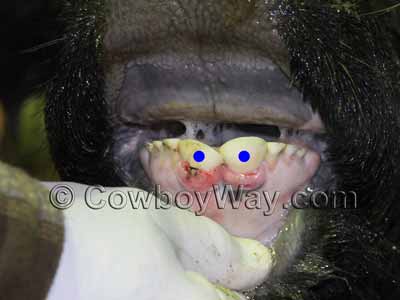
Actual Age: 24 - 26 months
Estimated Age: Two years

Age: Three
The second pair of permanent incisors (green dots) appear somewhere around age 2 1/2 years, and are typically fully developed by age three years.
Actual Age: Unknown
Estimated Age: Three years

Actual Age: Three years
Estimated Age: Three years

Age: Four
At approximately age 3 1/2 years the third pair of permanent incisors (red dots) are cut and are typically fully developed by age four years.
Actual Age: Four years
Estimated Age: Four years

Actual Age: Three-and-a-half years
Estimated Age: Four years

Age: Five
At approximately age 4 1/2 years the last of the cow's permanent incisor teeth (the "corner" incisors; pink dots) are cut, and are typically fully developed by age five years. Therefore, at age five years, cows typically have all eight of their permanent incisors erupted and in use. At this age the incisors are tall, relatively flat across the front (when compared to older ages), sharp at the top, and close together.
Actual Age: Unknown
Estimated Age: Five years

Actual Age: Five years
Estimated Age: Five years

Age: Six
From age six forward, estimating cattle age by their teeth is based on the degree of wear of the teeth. Estimating the age of cattle from this point forward becomes more difficult.
At age six years the cow's eight permanent incisor teeth will begin to show various degrees of wear. The tops of the teeth will still be comparatively sharp but will have begun to dull slightly, and the teeth will begin to take on a slightly rounded appearance from side-to-side (as opposed to appearing more flat from side-to-side as seen in younger ages). At age six the tops of teeth typically still touch, but subtle separations toward the bottom, between at least some of the teeth, may begin to appear. Commonly, little if any of the roots will be visible at the gum line.
Actual Age: Six years
Estimated Age: Six years
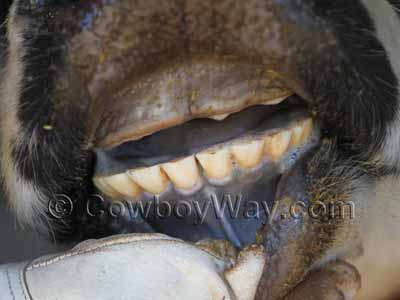
Age: Seven
At age seven years the cow's eight permanent incisor teeth will continue to show various degrees of wear. The tops of the teeth will show additional loss of sharpness, and the teeth will continue to appear slightly more rounded from side-to-side (as opposed to appearing more flat from side-to-side as seen in younger ages). At age seven there is commonly a separation, from subtle to definitely noticeable, between at least some of the teeth from top to bottom. The roots of the teeth may begin to be visible at the gum line.
NOTE: In the photos below all eight incisors were present in the cow, but sometimes cannot be seen in the photos.
Estimated Age: Seven years
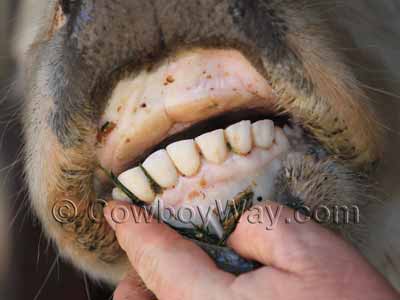
Actual Age: Seven years
Estimated Age: Seven years

Age: Short and Solid
After the age of seven some people will continue to estimate a cow's age in years. However, it is not uncommon around this time for a more general description of age to be used. If this is the case, the term "short and solid" might be used after the age of seven years.
A cow that is aged as "short and solid" will still have all eight permanent incisor teeth (unless there has been tooth loss due to some other cause except for age). Compared to younger ages the teeth will be shorter, and the tops will be smoother and less sharp. The teeth will continue to show additional rounding from side-to-side, and there is likely to be roots noticeable in the gum line.
The term "solid" in the age "short and solid" can refer to at least two things. "Solid" can mean there is no tooth loss, and/or it can mean that there are not any wide gaps between the teeth (although there may be narrower gaps). Exactly what "solid" means (no tooth loss and/or no very large gaps) can vary from region to region, sale barn to sale barn, or person to person.
NOTE: In the photo below all eight incisors were present in the cow, but cannot be seen in the photo.
Actual Age: Unknown
Estimated Age: Short and solid

Age: Short
In some areas, after the age of "short and solid" comes the age of "short." Not all areas/persons recognize the age "short" however, and will group cows in the "short" age group into the "short and solid" age group.
If the age group "short" is used, it is similar to "short and solid." However, a cow aged as "short" will have very short teeth with large gaps between most or all of them, often particularly at the bottom. Roots may be quite visible.
Actual Age: Unknown
Estimated Age: Short

Actual Age: Unknown
Estimated Age: Short

Age: Broken Mouth
The age "broken mouth" is older than the age "short." Commonly, a broken mouth cow is a cow that has lost one tooth due to age. In some areas, a cow is not a "broken mouth" until she has lost two teeth due to age.
NOTE: In the photo below the corner tooth on the left-hand side of the photo was present, but cannot be seen in the photo.
Actual Age: Unknown
Estimated Age: Broken mouth.
The blue arrow is pointing to a gap where a tooth is missing.
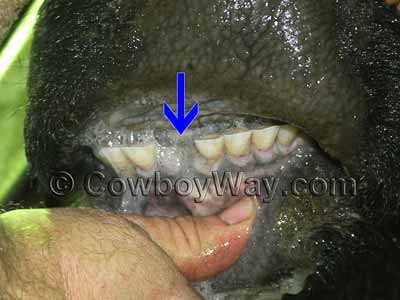
Age: Gummer
A "gummer" is often the oldest age description given to a cow. A gummer has lost several teeth due to age, or has worn them down until they are of little or no practical use.
Actual Age: Unknown
Estimated Age: Gummer

When Teeth Lie
As stated toward the top of this article, aging a cow by her teeth is a general estimate and may be inaccurate. Phrased another way, teeth sometimes lie. Below are just a couple of examples.
Actual Age: 24 - 26 months
Estimated Age: Younger than 18 months
This cow is 24 to 26 months old but still has only "baby" or "milk" teeth. Her first permanent incisors, which typically begin to erupt at approximately 1 1/2 years of age, have not even begun to erupt yet.
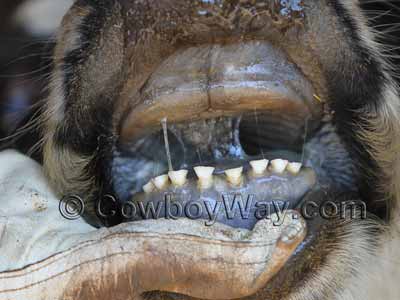
Actual Age: Three years
Estimated Age: Five years
This cow is three years old, but her teeth indicate that she is five years old. She has her first, second, and third set of permanent incisors (blue, green, and red dots, respectively), as well as one of her fourth permanent incisors (pink dot).

Aging Cattle By Their Teeth: Parting Comments
While there are guidelines about how teeth should look in cattle at a given age, it is impossible for these guidelines to take into account things such as environmental factors, diet, management practices, breed, individual variances, and other factors. Therefore, aging cattle by their teeth is an estimate or an opinion. Not everyone will estimate age the same.
Estimating a cow's age by her teeth is widely accepted as being her "mouth age," which may or may not be the same thing as her real age. For example, if someone looks at a cow's teeth to estimate her age, and a friend asks them how old they think the cow is, the answer might be something like: "I don't know, but her mouth is seven."
How To...
… Care For Your Felt Cowboy Hat
… Care For Your Saddle Pad Or Blanket
… Close A Gate With A Chain Latch
… Estimate Cattle Age By Their Teeth
… Fishtail Braid Your Horse's Tail
… Make A Bridle Rack Out Of Tin Cans
… Make A Collapsible Wood Saddle Rack
… Make A Flag Boot Out Of A Horn
… Make Homemade Hoof Conditioner
… Make Homemade Horse Fly Spray
… Measure A Western Saddle Seat
… Put A Horn Knot On Your Rope
… Put A Speed Burner On A Honda
… Recognize Common Horse Colors
… Recognize Common Horse Face Markings
… Stop A Saddle From Squeaking
… Tell A Boy Cow From A Girl Cow
… Tell A Horse Skull From A Cow Skull
… Tie A Stopper Knot
Tie a stopper knot for the end of a rope, or a metal, rawhide, or plastic honda
… Tie A Stopper Knot For A Honda
Tie a stopper knot for a tied honda
… Understand Leather / Hide Thickness
… Weigh A Horse and Optimize Rider Weight
… Wrap A Saddle Horn With Rubber
You Might Also Like...
